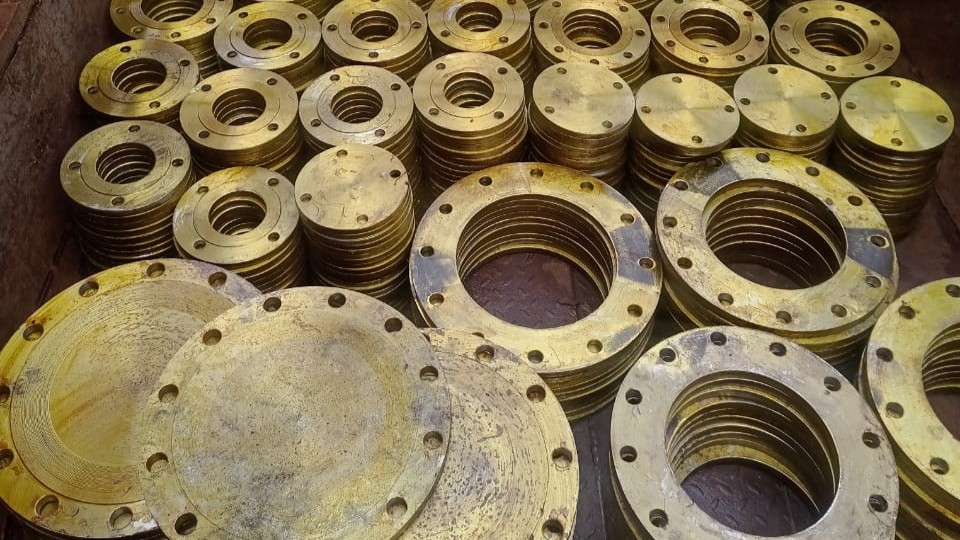Mild Steel (MS) Flanges and Stainless Steel (SS) Flanges are widely used in various industries due to their unique properties and applications.

Applications
- MS Flanges: These flanges are made from mild steel, which is cost-effective and easy to weld. They are commonly used in industries like oil and gas, water treatment, and chemical processing. MS flanges are ideal for low-pressure applications and environments where corrosion resistance is not a primary concern2.
- SS Flanges: Stainless steel flanges are highly resistant to corrosion and can withstand high temperatures and pressures. They are extensively used in industries such as petrochemical, food and beverage, construction, and automotive. SS flanges are preferred in applications requiring durability and leak-proof connections, such as pipelines carrying corrosive fluids4.
Types
Both MS and SS flanges come in various types to suit different applications:
- Slip-On Flanges: Easy to install and suitable for low-pressure applications3.
- Weld Neck Flanges: Designed for high-pressure and high-temperature systems, offering strong connections3.
- Blind Flanges: Used to seal the end of a pipe or isolate sections for maintenance3.
- Socket Weld Flanges: Ideal for small-diameter, high-pressure applications3.
- Threaded Flanges: Convenient for low-pressure systems without welding3.
- Lap Joint Flanges: Used in systems requiring frequent disassembly.
- Ring-Type Joint Flanges: Provide a secure seal for high-pressure applications.
Different Standards of Steel Flanges
Steel flanges are manufactured according to various international standards to ensure compatibility, safety, and performance in different applications. Here are some of the most common standards and their uses:
1. ASME/ANSI Standards
- ASME B16.5: Covers pipe flanges and flanged fittings for sizes ranging from ½ inch to 24 inches. It includes pressure classes like 150, 300, 600, 900, 1500, and 2500. These flanges are widely used in industries like oil and gas, chemical processing, and power generation.
ANSI-B16.5 / ASA 150 Flange Dimensions
ANSI-B16.5 / ASA 300 Flange Dimensions
In India the above standard is the second most commonly used standard in Industrial setting. Commonly referred to as ASA flanges or ANSI flanges.
Check out the official standard data on their official website ansi.org.
- ASME B16.47: Focuses on large-diameter flanges (26 inches to 60 inches) and includes Series A (heavy-duty) and Series B (lighter applications). Commonly used in pipelines and high-pressure systems.
2. DIN/EN Standards
- DIN 2633/EN 1092-1: European standards for steel and stainless steel flanges. These are commonly used in industries across Europe and Asia, especially in systems requiring metric measurements. They are suitable for applications like water treatment and food processing.
3. JIS Standards
- JIS B2220: Japanese Industrial Standard for flanges, widely used in Asian markets. These flanges are known for their precision and are often used in automotive and manufacturing industries.
4. API Standards
- API 605: Designed for flanges used in the petroleum industry, particularly in pipelines and systems handling high pressure and harsh conditions.
5. ASTM Standards
- ASTM A105: Specifies carbon steel forged flanges for general piping systems, especially in industrial and chemical applications.
- ASTM A182: Covers alloy steel and stainless steel flanges, suitable for high-temperature and corrosive environments.
Last but not the least…
6. BS10 Standard
- Table D and E: These are commonly used for low-pressure applications, such as water pipelines and general-purpose systems.
BS10 Table D Flange Dimensions
BS10 Table E Flange Dimensions - Table F and G: These flanges are suitable for medium-pressure systems, often found in industries like chemical processing and HVAC systems.
- Table H: Designed for high-pressure applications, these flanges are used in more demanding environments, such as steam pipelines and industrial machinery.
This is the most commonly used standard of flanges in India, BS10, used both in industrial settings and commercial.
Check out the complete official standard data on their office website en-standard.eu.
The BS10 standard flanges are widely used in regions where British standards are prevalent, including the UK and Commonwealth countries. They are often employed in:
- Water Treatment Plants: For pipelines carrying water at low to medium pressures.
- Industrial Systems: In applications requiring moderate to high-pressure resistance.
- Marine Applications: Due to their durability and compatibility with various materials.
Common application of other standards are as follows:
- Oil and Gas: ASME and API flanges are commonly used due to their ability to handle high pressure and temperature.
- Chemical Processing: ASTM and DIN flanges are preferred for their corrosion resistance.
- Water Treatment: DIN and EN flanges are widely used for their compatibility with metric systems.
- Food and Beverage: Stainless steel flanges adhering to DIN or JIS standards are ideal for hygienic applications.
For other MS pipes and fittings specifications check out:
MS Pipes Size Charts
Check out the pricelist for mild steel commercial flanges here:
MS Flanges pricelist